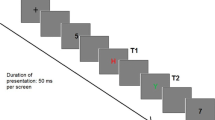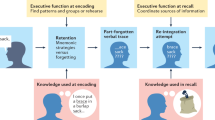Abstract
Background and aims: A number of studies suggest that age differences in working memory may be attributed to age-related differences in inhibitory efficacy. Nevertheless, little is known about the impact of intrusive thoughts, which occurs in everyday situations on working memory performance. This study investigates the role of cognitive and everyday inhibition mechanisms in working memory performance. Methods: Young, young-old and old-old adults performed a working memory task and the White Bear Suppression Inventory (WBSI). Results: Results showed a decrease in working memory, and in inhibitory efficacy with age. In addition, old-old adults obtained higher scores in the three factors of the WBSI. Working memory performance was related to working memory control of interfering information in all age groups, and also to the tendency to suppress thoughts in old-old adults. The latter result was in the opposite direction with respect to observations collected with younger adults. Conclusions: Taken together, our results suggest the crucial role of intrusive thoughts in the functional capacity of working memory in late adulthood.
Similar content being viewed by others
References
Hasher L, Zacks RT. Working memory, comprehension and aging: a review and new view. In Bower GH, Ed. The Psychology of Learning and Motivation. San Diego, CA: Academic Press, 1988: 193–225.
Friedman NP, Miyake A. The relations among inhibition and interference control functions: a latent-variable analysis. J Exp Psychol Gen 2004; 133: 101–35.
Nigg JT. On inhibition/disinhibition in developmental psychopathology: views from cognitive and personality psychology and a working inhibition taxonomy. Psychol Bull 2000; 126: 220–46.
Hasher L, Quig MB, May CP. Inhibitory control over no-longer-relevant information: adult age differences. Mem Cognit 1997; 25: 286–95.
Brewin CR, Beaton A. Thought suppression, intelligence and working memory capacity. Behav Res Ther 2002; 40: 923–30.
Wegner DM, Schneider DJ, Carter SRIII, White L. Paradoxical effects of thought suppression. J Pers Soc Psychol 1987; 53: 5–13.
Wegner DM, Zanakos, S. Chronic thought suppression. J Pers 1994; 62: 615–40.
Blumberg SJ. The white bear suppression inventory: revisiting its factor structure. Pers Individ Dif 2000; 29: 943–50.
Persad CC, Abeles N, Zacks RT, Denburg NL. Inhibitory changes after age 60 and their relationship to measures of attention and memory. J Gerontol 2002; 57: 223–32.
Hedden T, Park D. Aging and interference in verbal working memory. Psychology and Aging 2001; 16: 666–81.
Powers CB, Wisocki PA, Whitbourne SK. Age differences and correlates of worrying in young and elderly adults. Gerontologist 1992; 32: 82–8.
Hess TM. Memory and aging in context. Psychol Bull 2005; 131: 383–406.
Hunt S, Wisocki P, Yanko J. Worry and use of coping strategies among older and younger adults. J Anxiety Disord 2003; 17: 547–60.
De Beni R, Palladino P, Pazzaglia F, Cornoldi C. Increases in intrusion errors and working memory deficit of poor comprehenders. Q J Exp Psychol 1998; 51A: 305–20.
Carretti B, Cornoldi C, De Beni R, Palladino P. What happens to information to be suppressed in working memory tasks? Short and long term effects. Q J Exp Psychol 2004; 57A: 1059–84.
De Beni R, Palladino P. Intrusion errors in working memory task: are they related to reading comprehension ability? Learn Individ Differ 2000; 12: 131–43.
De Beni R, Palladino P. Decline in working memory updating through ageing: intrusion error analyses. Memory 2004; 12: 75–89.
Osaka M, Nishizaki Y, Komori M, Osaka N. Effect of focus on verbal working memory: critical role of the focus word in reading. Mem Cognit 2002; 30: 562–71.
Kane MJ, Engle RW. The role of prefrontal cortex in working-memory capacity, executive attention, and general fluid intelligence: an individual-differences perspective. Psychon Bull Rev 2002; 9: 637–71.
Kogan JL, Edelstein BA. Modification and psychometric examination of a self-report measure of fear in older adults. Anxiety Disord 2004; 18: 397–409.
Crook T, Bartus RT, Ferris SH, Whitehouse P, Cohen GD, Gershon S. Age-associated memory impairment: proposed diagnostic criteria and measures of clinical change. Report of a National Institute of Mental Health work group. Dev Neuropsychol 1986; 2: 261–76.
Lindenberger U, Baltes PB. Intellectual functioning in old and very old age: cross-sectional results from the Berlin Aging Study. Psychol Aging 1997; 12: 410–32.
Gamboz N, Russo R, Fox E. Age differences and the identity negative priming effect: an updated meta-analysis. Psychol Aging 2002; 17: 525–31.
Borella E, Carretti B, Mammarella IC. The relationship between working memory, proactive interference and fluid intelligence in young adults and elderly. Eur J Cogn Psychol 2006; 18: 51–69.
Park DC, Lautenschlager G, Smith AD, et al. Mediators of long-term memory performance across the lifespan. Psychol Aging 1996; 11: 621–37.
de Ribaupierre A, Borella E, Delaloye C. Inhibition et variabilité individuelle: généralité ou spécificité des processus inhibiteurs. In Moutier S, Ed. Inhibition neurale et cognitive. Paris: Hermès, 2003: 103–24.
Baltes PB, Smith J. New frontiers in the future of aging: from successful aging of the young old to the dilemmas of the fourth age. Gerontology 2003; 49: 123–35.
Wells A, Davies MI. The thought control questionnaire: a measure of individual differences in the control of unwanted thoughts. Behav Res Ther 1994; 32: 871–8.
Wegner DM. White bears and other unwanted thoughts: suppression, obsession, and the psychology of mental control. New York: Viking/Penguin, 1989.
Baltes PB. Theoretical propositions of lifespan developmental psychology: on the dynamics between growth and decline. Dev Psychol 1987; 23: 611–26.
Conway ARA, Kane MJ, Bunting MF, Hambrick DZ, Wilhelm O, Engle RW. Working memory span tasks: a methodological review and user’s guide. Psychon Bull Rev 2005; 12: 769–86.
Author information
Authors and Affiliations
Rights and permissions
About this article
Cite this article
Borella, E., Carretti, B., Cornoldi, C. et al. Working memory, control of interference and everyday experience of thought interference: when age makes the difference. Aging Clin Exp Res 19, 200–206 (2007). https://doi.org/10.1007/BF03324690
Received:
Accepted:
Published:
Issue Date:
DOI: https://doi.org/10.1007/BF03324690




